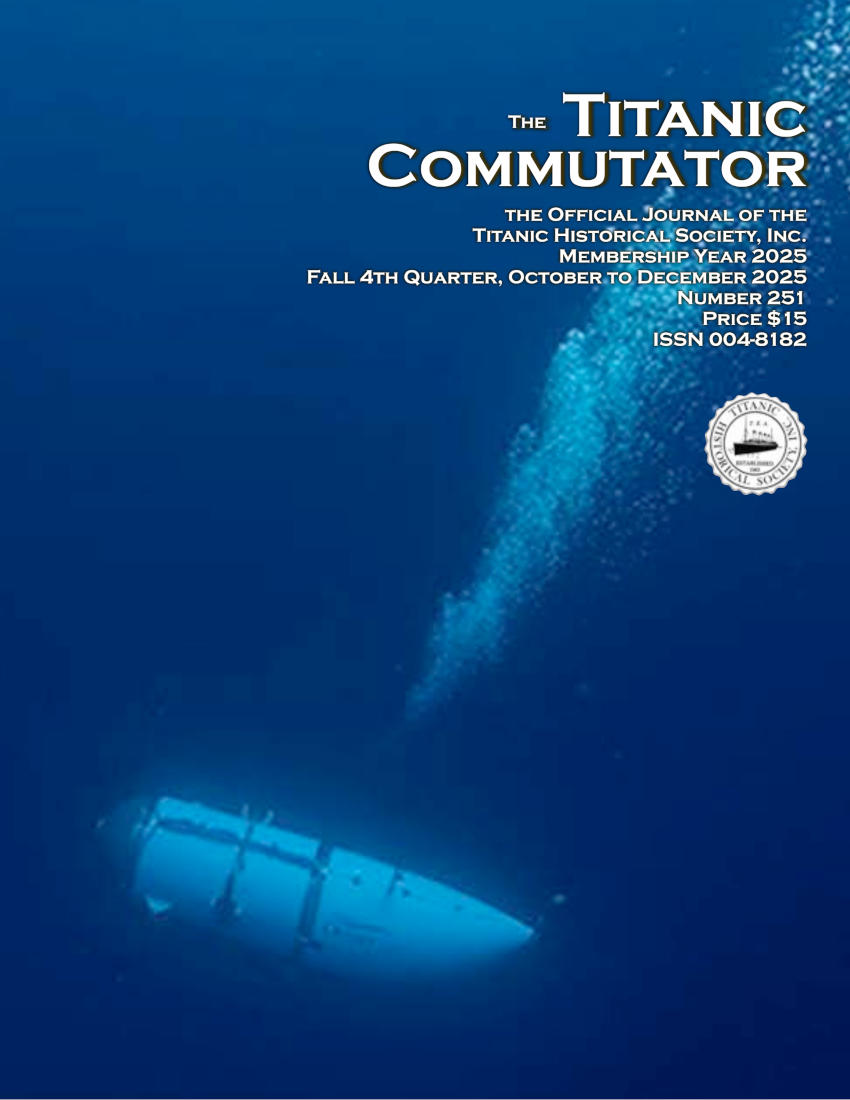Titanic Historical Society Commutator 251
THS Commutator No. 251, Fall 4th Quarter, October to December 2025
Contents
Baltic: ‘There is Nothing Very Striking About This Steamer…’ by Mark Chirnside
Shipping lines were constantly keeping an eye on their competitors to look for particular ideas that they might incorporate into their new ships. In July 1904, one set of notes was prepared, stamped for the Board of the Cunard Steamship Company. The notes consisted of a short summary report about White Star’s new Baltic.
Baltic II Sideswiped by an Oil Tanker-Vintage Vignettes-
Laurentic in the Panama Canal
Shipping companies will always look for new and different destinations to attract passengers. At the beginning of the 20th century, the wonder of the age was the construction of Panama Canal, an unprecedented engineering feat. David McCulloch’s book, The Path Between the Seas description: “The building of the Panama Canal was one of the most grandiose, dramatic, and sweeping adventures of all time. It held the world’s attention for over forty years from its beginnings by France to its completion by the United States on the eve of World War I…
S.S. Olympic in the Panama Canal?
The appearance (image) of Olympic in the Panama Canal raised some questions. What was she doing there? We know Olympic never sailed in the Panama Canal. At the time Olympic was the newest and largest ship [in the White Star Line] and represented the image of the Company. The thinking at the time was consideration to expand to the West Coast with docking facilities in San Francisco or Oakland when the Panama Canal opened. White Star ships chartered in the Occidental & Oriental Steamship Co. had been sailing from San Francisco until O & O ceased operations in 1906. We will never know if White Star on the West Coast would ever have come to pass because Fate intervened––at the same time the Panama Canal officially opened––World War One broke out in August 1914 and changed everything.
Titan––What went wrong in June 2023-
A damning report published by the US Coast Guard today looked at what went wrong in June 2023, when the Titan submersible took five people on an expedition to see the Titanic shipwreck – but the sub imploded, killing all on board.
The implosion of the vessel was caused by the loss of structural integrity of its carbon fibre hull, exposing passengers to “approximately 4,930 pounds per square inch of water pressure”, the report found. They died instantaneously.
The tragedy was “preventable”, it said.
Investigators found “critically flawed” safety practices at the sub’s owner OceanGate Expeditions, and said it used “intimidation tactics” for several years before the disaster to avoid scrutiny.
Much of the blame goes to the Chief Executive Stockton Rush, the US Coast Guard said. He was on board and also died in the disaster. The report found he “exhibited negligence that contributed to the deaths of four individuals”.
The Blue Riband, excerpted from Shipping Wonders of the World (1936)
What was required to become an officer on a large ocean liner in 1912? Where did he go to learn? How did he gain practical experience?
Young men who intended to become officers of the mercantile marine were encouraged, if possible, to join a training ship. For the well-to-do there was the Conway in the Mersey near Liverpool, and the Worcester which was in the Thames off Greenhithe. Both were formerly wooden steam warships, and under the command of naval officers. The instructors were largely drawn from naval sources and both vessels had facilities for sending cadets to the Royal Naval College at Osborne.
Oceanic House by Paul Louden Brown
One of the most coveted honors of the sea, the Blue Riband––there was no formal award until 1935––the trophy has a history that is dramatic and interesting. Sailing ship races with China tea to a less extent with Australian wool, attracted almost as much attention in the middle of the nineteenth century as the Derby does today. The names of ships and their captains were household words then and with the lay public. Now it is the Blue Riband of the Atlantic.








